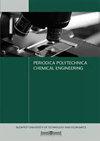粗甘油基培养基生产黄原胶的本地野生黄单胞菌的筛选
IF 1.8
4区 工程技术
Q3 ENGINEERING, CHEMICAL
引用次数: 1
摘要
本研究研究了栽培时间对油菜黄单胞菌和辣椒黄单胞菌分别从十字花科植物和辣椒叶中分离的黄单胞菌合成黄原胶的影响。黄原胶是在实验室水平的粗甘油培养基上,在30°C和150 rpm的好氧条件下,在168 h和240 h下深层培养产生的。根据生物过程结束时培养基中的黄原胶浓度及其平均分子量来估计生物过程效果。所得结果表明,当euvesicatoria菌株进行生物合成时,黄单胞菌菌株对培养基中黄原胶浓度的影响具有统计学意义,而只有当X.campestris菌株进行生物合成时,培养时间才对该参数有显著影响。黄单胞菌菌株组合和培养时间对两组分离菌培养基中黄原胶浓度的影响均有统计学意义。结果表明,各施用黄单胞菌菌株、培养时间及其组合对试验条件下黄原胶平均分子量的影响均有统计学意义。结果表明,与葡萄球菌相比,葡萄球菌在较短的时间内(168 h)产生较多的黄原胶。两组菌株在应用实验条件下培养240 h,均可获得较高平均分子量的黄原胶。本研究结果表明,该菌株在粗甘油基培养基上生物技术生产黄原胶方面具有很大的应用潜力。本文章由计算机程序翻译,如有差异,请以英文原文为准。
Screening of Local Wild Xanthomonas Species for Xanthan Production on Crude Glycerol-based Medium
In this study, the effect of cultivation time on xanthan biosynthesis by different Xanthomonas campestris and Xanthomonas euvesicatoria strains, isolated from crucifers and pepper leaves, respectively, was examined. Xanthan was produced by submerged cultivation on crude glycerol-based medium at a laboratory level under aerobic conditions at 30 °C and 150 rpm for 168 h and 240 h. Bioprocess efficacy was estimated based on the xanthan concentration in media at the end of bioprocess and its average molecular weight. According to the obtained results, Xanthomonas strains have statistically significant effect on xanthan concentration in cultivation media when biosynthesis is performed by X. euvesicatoria strains, and cultivation time has significant effect on this parameter only when bioprocess is performed by X.campestris strains. The combination of Xanthomonas strains and cultivation time has a statistically significant effect on xanthan concentration in medium for both groups of isolates. The obtained results show that all applied Xanthomonas strains and cultivation time as well as their combination have statistically significant effect on average molecular weight of xanthan produced in applied experimental conditions. It is found that X. euvesicatoria strains produce higher amount of xanthan in a shorter period of time (168 h) when compared to the X.campestris strains. Xanthan of higher average molecular weight was produced when cultivation of both groups of isolates was performed for 240 h in applied experimental conditions. Results obtained in this research suggest that X. euvesicatoria strains have the greatest potential for application in biotechnological production of xanthan on crude glycerol-based medium.
求助全文
通过发布文献求助,成功后即可免费获取论文全文。
去求助
来源期刊

Periodica Polytechnica Chemical Engineering
ENGINEERING, CHEMICAL-
CiteScore
3.10
自引率
7.70%
发文量
44
审稿时长
>12 weeks
期刊介绍:
The main scope of the journal is to publish original research articles in the wide field of chemical engineering including environmental and bioengineering.
 求助内容:
求助内容: 应助结果提醒方式:
应助结果提醒方式:


